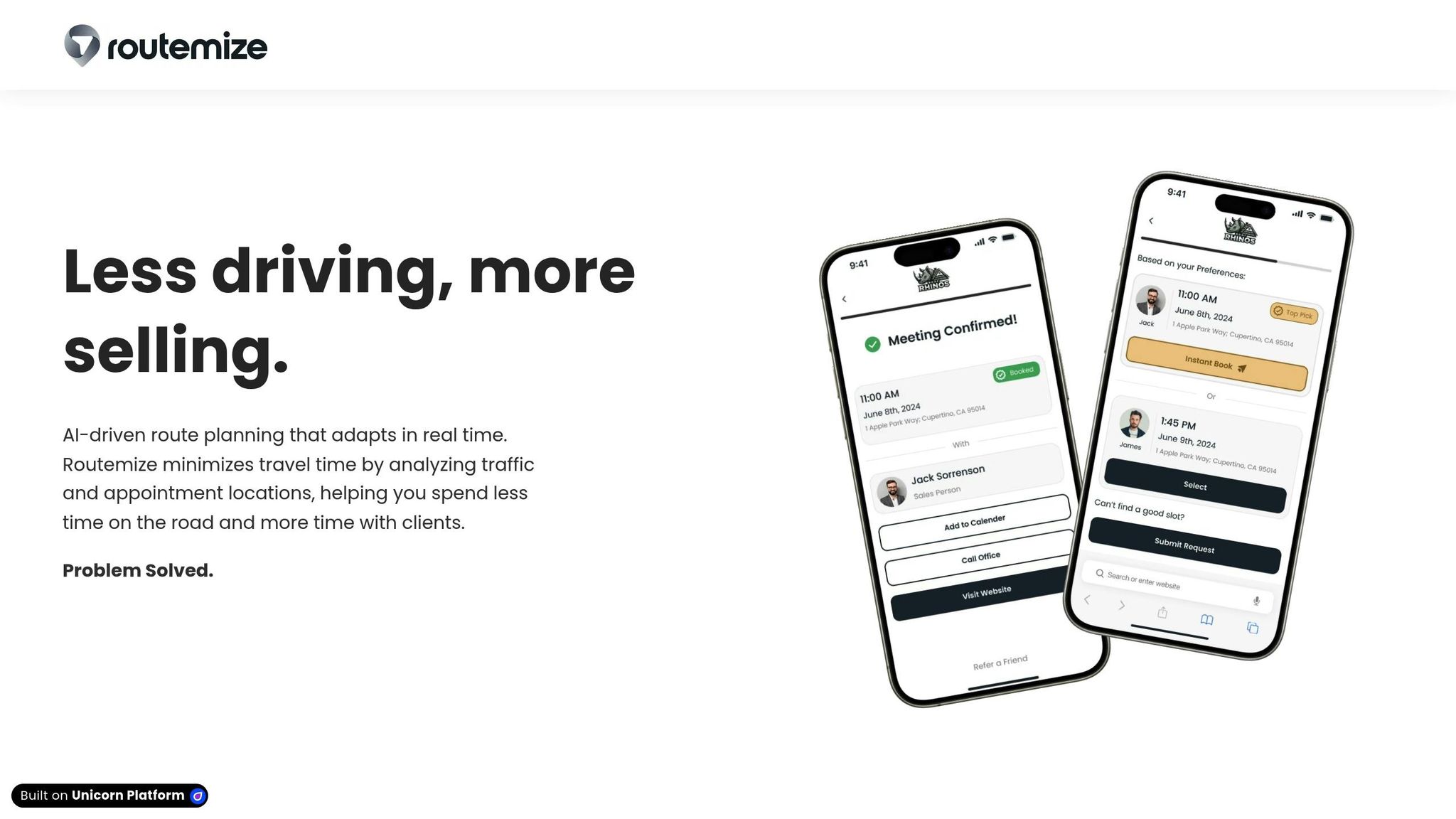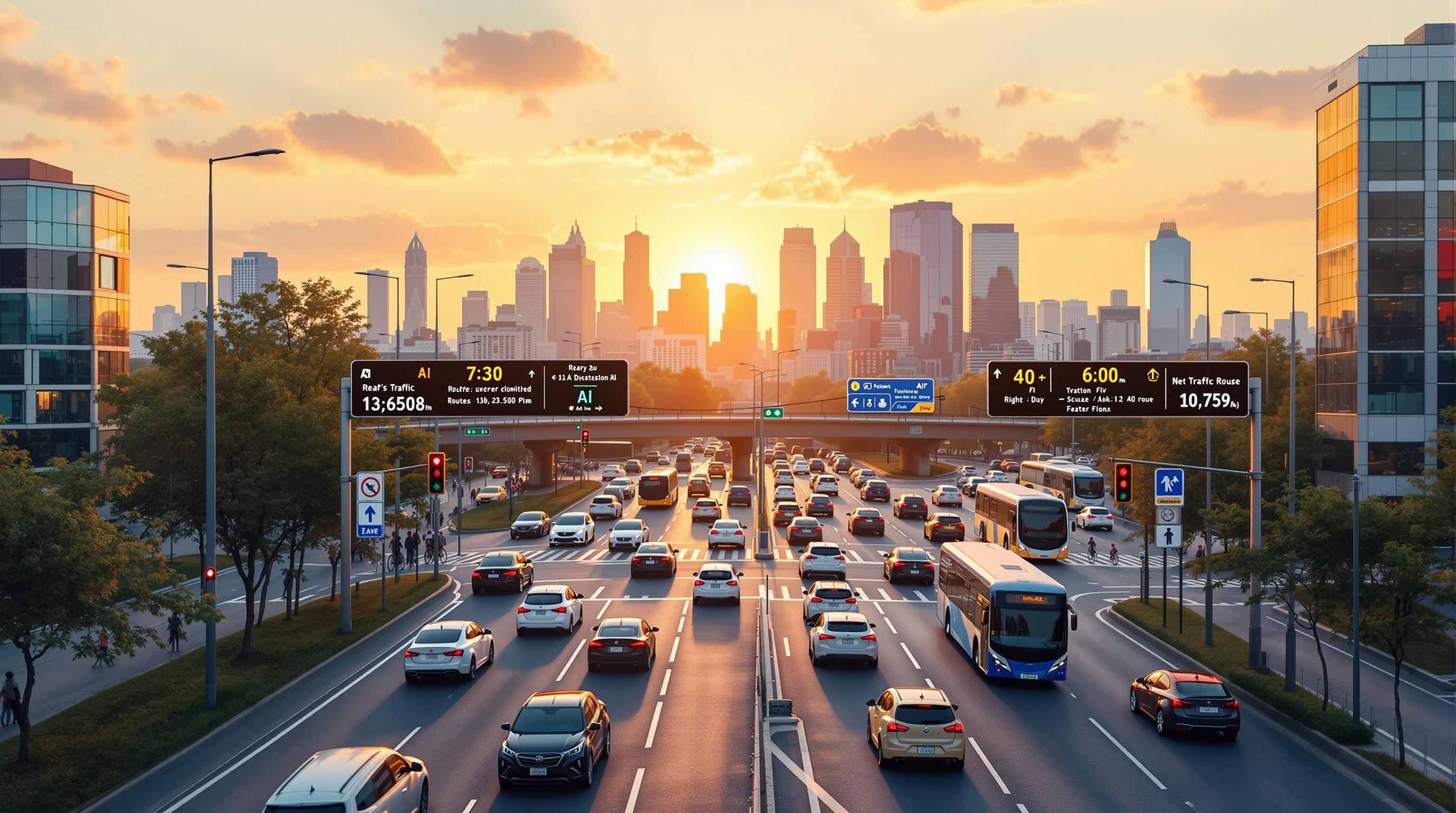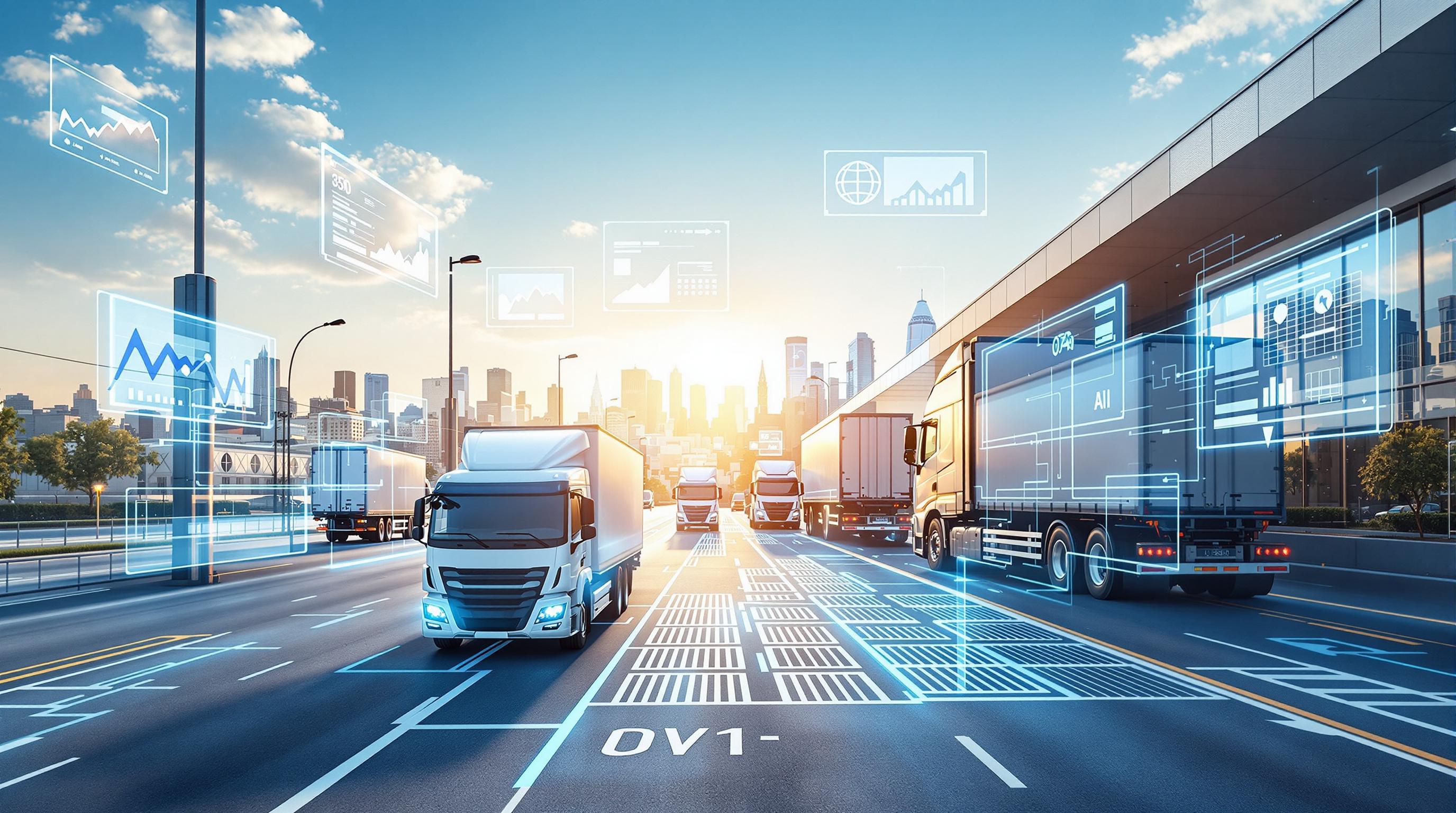AI route optimization can cut fuel costs by up to 20% while improving delivery times and reducing carbon emissions. Here's how:
- Fuel Savings: Shorter routes, less idling, and real-time traffic updates save 15-20% on fuel costs.
- Increased Efficiency: Delivery speeds improve by up to 30%, allowing more jobs per day without extra resources.
- Environmental Benefits: Reducing fuel consumption lowers emissions by up to 20%.
Quick Example: UPS saved $320 million and cut fuel use by 10 million gallons using its AI-powered ORION platform.
AI systems like Routemize analyze real-time traffic, weather, and vehicle data to create efficient routes, saving money and supporting sustainability goals. Keep reading to learn how businesses are achieving these results.
AI Route Optimization Reducing Travel Time and Emissions
Core Elements of AI Route Planning
AI-powered route planning takes fuel efficiency to the next level by focusing on three essential components.
Live Traffic Updates
AI systems use real-time data from sources like traffic cameras, sensors, and GPS to make quick, informed decisions about routing. By steering drivers away from congested areas, these systems help reduce the fuel wasted in stop-and-go traffic.
Take Pittsburgh, for example. The city's AI-driven traffic light system has cut travel times by 25% and reduced vehicle emissions by 20%. In Los Angeles, the ATSAC system - an AI-based traffic control tool - adjusts signal timing based on live traffic patterns, leading to a 12% improvement in travel times.
These advancements ensure smoother traffic flow, minimizing idling and unnecessary stops.
Auto Route Updates
Modern AI routing systems continuously update delivery routes in real time, slashing fuel costs by up to 15%. They achieve this by factoring in a variety of real-world conditions, such as:
- Current weather
- Road construction
- Traffic accidents
- Driver availability
- Last-minute customer changes
This dynamic recalibration can reduce fuel usage by as much as 20%, while also streamlining operations.
Fuel-Saving Route Logic
AI-based route planning is a major leap forward compared to traditional methods. Here’s a quick comparison:
| Aspect | Traditional Planning | AI-Driven Optimization |
|---|---|---|
| Data Analysis | Relies on static maps and old data | Uses real-time traffic, weather, and predictive analytics |
| Route Adaptation | Fixed routes with manual updates | Automatically adjusts to current conditions |
| Efficiency Parameters | Focuses on basic distance and time | Considers fuel efficiency, costs, and emissions |
| Environmental Impact | Minimal focus | Actively reduces carbon footprint |
Business Gains from AI Routes
Smart route planning powered by AI isn't just about efficiency - it delivers clear, measurable benefits for businesses.
Reduced Fuel Costs
AI-driven route optimization helps businesses save on fuel by fine-tuning travel paths and making real-time adjustments. Here’s how it works:
- Shorter travel distances: Routes are planned to minimize mileage.
- Less idle time: Improved scheduling reduces unnecessary waiting.
- Real-time traffic updates: Avoiding congested areas saves fuel and time.
- Optimized cargo loads: Ensuring vehicles carry loads efficiently.
These strategies have proven effective, with businesses seeing fuel savings of 15-20% across fleets of all sizes and industries.
Increased Daily Productivity
With AI systems in place, delivery times are faster, and schedules are more streamlined. Companies report up to a 30% increase in delivery speeds, allowing them to handle more jobs each day - all without adding extra vehicles or staff. By factoring in delivery priorities, vehicle types, and capacities, AI ensures every route is optimized for peak performance while maintaining high service standards.
Reduced Carbon Emissions
Cutting fuel consumption doesn't just save money - it also reduces environmental impact. AI route optimization helps businesses lower their carbon footprint by minimizing idle time and unnecessary driving. Many companies report emissions reductions of up to 20%. These solutions demonstrate that operational efficiency and environmental responsibility can go hand in hand.
These benefits highlight how AI-powered routing technology not only enhances business operations but also aligns with sustainability goals, paving the way for tools like Routemize to take efficiency to the next level.
sbb-itb-7020db0
Routemize Features and Uses

Building on the operational improvements already discussed, Routemize offers a range of specialized tools powered by advanced AI technology, designed to maximize efficiency and reduce fuel costs.
Routemize Basic Functions
Routemize uses real-time data to design fuel-efficient routes by analyzing traffic patterns, appointment locations, and vehicle metrics. It continuously tracks road conditions and traffic updates, making automatic route adjustments to avoid delays and minimize fuel consumption.
Here’s a breakdown of its key features:
| Feature | Benefit | Impact on Fuel Savings |
|---|---|---|
| Real-time Traffic Analysis | Identifies and avoids congested areas | Reduces idle time and unnecessary fuel use |
| Dynamic Route Adjustment | Updates routes based on current conditions | Optimizes travel distances for better mileage |
| Load Optimization | Maximizes vehicle capacity usage | Cuts down on empty mileage and fuel expenses |
These essential features lay the groundwork for Routemize’s more advanced tools.
Main Routemize Tools
Routemize builds on its foundational functions with tools specifically designed to enhance fuel efficiency and streamline operations:
- Smart Scheduling: Plans routes to minimize backtracking, reducing empty miles and saving fuel.
- Fleet Analytics: Tracks fuel usage and vehicle performance across the entire fleet, offering actionable insights.
- Performance Dashboard: Provides real-time monitoring of route efficiency and highlights areas for improvement.
Business Use Examples
Here’s how businesses are using Routemize to achieve measurable results:
- Field Service Operations: A service company slashed fuel consumption by 25% after adopting advanced routing software that optimized routes and avoided traffic congestion.
- Multi-Stop Deliveries: Another business saved 30% on fuel costs by utilizing real-time traffic data and dynamic route adjustments.
These examples highlight how AI-powered route optimization not only reduces fuel expenses but also aligns with broader environmental goals.
Setting Up AI Route Planning
Implementing an AI-powered routing system, like Routemize, is a key step toward achieving consistent fuel savings and improving operational efficiency. Here's how to get started.
Review Current Routes
Begin by gathering 3–6 months of route data to establish a baseline. Focus on these key metrics:
- Fuel consumption records
- Average travel times between stops
- Total mileage per route
- Idle time statistics
- Delivery completion rates
These figures will help you measure the impact of AI-driven routing. For instance, if your field service teams average 12.3 miles per service call, this becomes your benchmark for tracking improvements.
Additionally, document insights in the following areas:
| Analysis Area | Key Data Points | Purpose |
|---|---|---|
| Scheduling Patterns | Peak hours, recurring delays | Pinpoint bottlenecks |
| Driver Feedback | Common route challenges | Identify operational issues |
| Fuel Usage | Consumption patterns, costs | Set baseline metrics |
| Service Times | Average duration per stop | Refine scheduling strategies |
Pick Your AI System
Choose an AI routing system designed to maximize fuel efficiency. Look for features such as:
- Real-time traffic updates
- Dynamic route adjustments
- Comprehensive fuel usage tracking
Routemize, for example, continuously optimizes routes in response to changing conditions, reducing unnecessary fuel consumption through smart routing.
Ensure the system integrates seamlessly with your existing tools like dispatch software, CRM, and fleet management systems. Also, take into account specific needs such as vehicle restrictions, service area limits, customer time windows, and any special handling requirements.
Once implemented, use clear KPIs to assess the system's effectiveness.
Track Your Results
Regularly monitor key performance indicators (KPIs) to evaluate progress. Use the 12.3-mile benchmark from your initial review to measure improvements. Focus on metrics like:
| Metric | Measurement Method |
|---|---|
| Fuel Consumption | Gallons per delivery |
| Route Efficiency | Average miles per service call |
| Job Completion | Total jobs completed per day |
| Idle Time | Total idle minutes per route |
Review these metrics weekly and conduct a deeper analysis every quarter. Many businesses report immediate efficiency gains of 10–15%, with further improvements as the system learns and adapts to your operations.
To validate results, compare current performance against baseline data. Look at fuel savings across different service areas, monitor seasonal consumption trends, and calculate ROI based on actual fuel cost reductions. Regularly update your data and system parameters to maintain and enhance long-term efficiency.
Summary
AI-powered route optimization offers a game-changing way to cut fuel costs and improve overall operations. By analyzing real-time data - like traffic, weather, and road conditions - these systems identify the most efficient routes, reducing mileage and idle time.
This approach not only lowers fuel expenses but also reduces maintenance costs, increases the number of completed service calls, and boosts customer satisfaction. Vehicles endure less wear and tear, teams accomplish more in a day, and customers enjoy faster, more reliable service.
What really sets AI systems apart is their ability to adapt in real time. When disruptions occur, routes are recalibrated on the fly, keeping operations running smoothly. Plus, these optimizations contribute to reducing carbon emissions, supporting environmental goals.
For businesses, choosing the right AI routing solution is key. Systems like Routemize stand out by combining detailed tracking with dynamic adjustments, ensuring both immediate and long-term benefits. Their ability to streamline operations and cut costs makes them a strong choice for companies aiming to enhance efficiency and sustainability.
FAQs
How does AI-powered route optimization help lower carbon emissions, and what are its environmental advantages?
AI-driven route optimization plays a key role in cutting down carbon emissions by pinpointing the most efficient travel routes. By shortening travel distances and reducing time on the road, it directly lowers fuel consumption, which in turn decreases greenhouse gas emissions.
But the impact doesn’t stop there. Using less fuel also means reducing the overall carbon footprint of transportation. This not only helps in creating cleaner air but also supports efforts toward a greener and more environmentally friendly future.
How does Routemize improve efficiency and save fuel compared to traditional route planning methods?
Routemize uses AI-powered route optimization to create smarter and more efficient travel plans. Instead of relying on outdated, static planning methods, it adjusts routes in real time by analyzing key factors like traffic conditions and appointment locations. This dynamic approach helps drivers cut down on time spent on the road, leading to lower fuel usage and reduced travel expenses.
By prioritizing the most efficient paths, Routemize not only saves users time and money but also boosts productivity by eliminating unnecessary mileage.
How can businesses evaluate the benefits of using AI-powered route optimization for fuel savings and efficiency?
To understand how AI-powered route optimization can make a difference, businesses should track key metrics like fuel consumption, travel time, and operational costs both before and after adopting the technology. Comparing these numbers can reveal how much efficiency and savings have been achieved.
Take tools like Routemize, for instance. These solutions adjust routes in real time, factoring in traffic conditions and appointment locations. The result? Fewer miles traveled and less time spent on the road. By monitoring these reductions over time, businesses can clearly see how much they've saved on fuel and how their overall productivity has improved.


